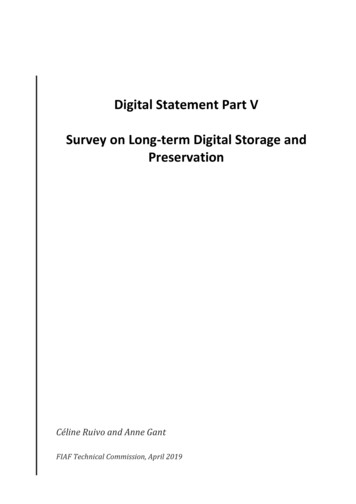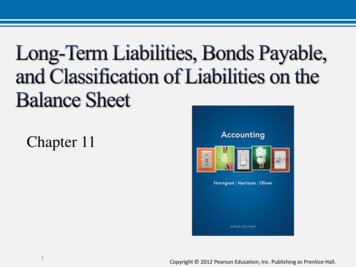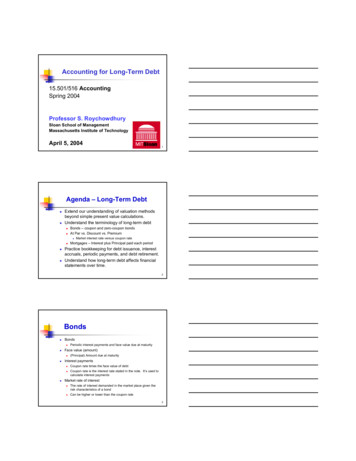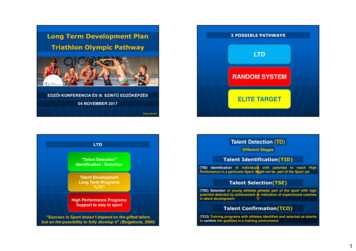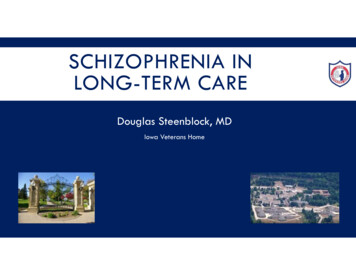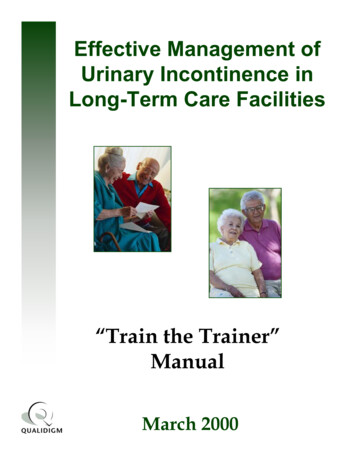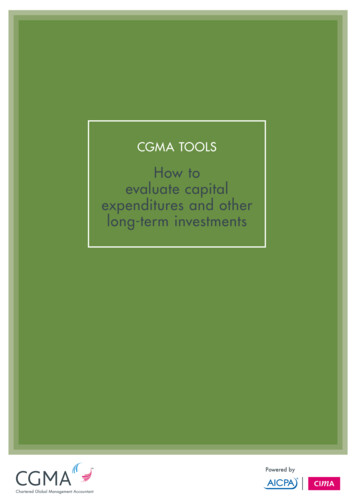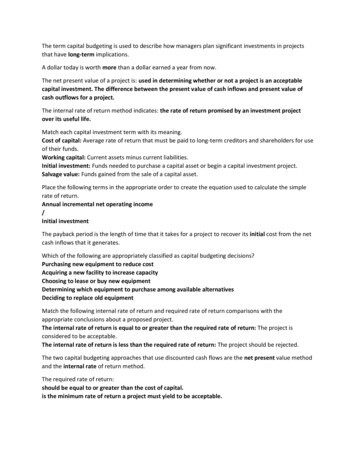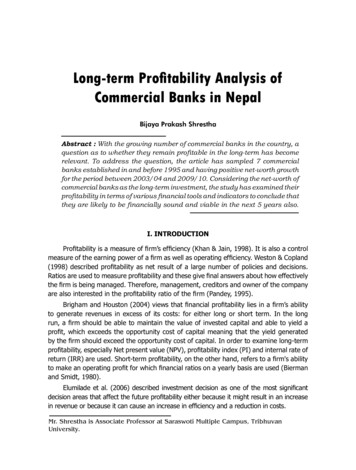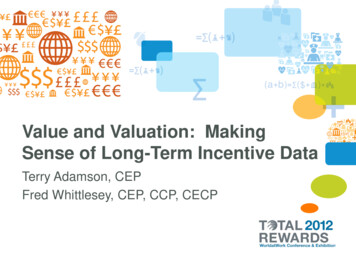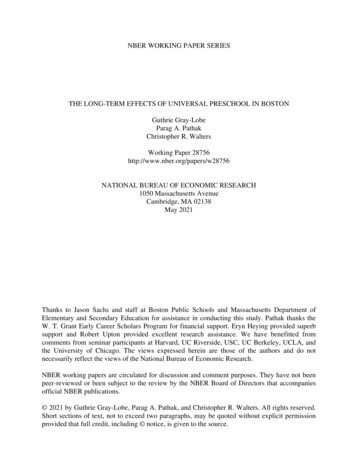
Transcription
NBER WORKING PAPER SERIESTHE LONG-TERM EFFECTS OF UNIVERSAL PRESCHOOL IN BOSTONGuthrie Gray-LobeParag A. PathakChristopher R. WaltersWorking Paper 28756http://www.nber.org/papers/w28756NATIONAL BUREAU OF ECONOMIC RESEARCH1050 Massachusetts AvenueCambridge, MA 02138May 2021Thanks to Jason Sachs and staff at Boston Public Schools and Massachusetts Department ofElementary and Secondary Education for assistance in conducting this study. Pathak thanks theW. T. Grant Early Career Scholars Program for financial support. Eryn Heying provided superbsupport and Robert Upton provided excellent research assistance. We have benefitted fromcomments from seminar participants at Harvard, UC Riverside, USC, UC Berkeley, UCLA, andthe University of Chicago. The views expressed herein are those of the authors and do notnecessarily reflect the views of the National Bureau of Economic Research.NBER working papers are circulated for discussion and comment purposes. They have not beenpeer-reviewed or been subject to the review by the NBER Board of Directors that accompaniesofficial NBER publications. 2021 by Guthrie Gray-Lobe, Parag A. Pathak, and Christopher R. Walters. All rights reserved.Short sections of text, not to exceed two paragraphs, may be quoted without explicit permissionprovided that full credit, including notice, is given to the source.
The Long-Term Effects of Universal Preschool in BostonGuthrie Gray-Lobe, Parag A. Pathak, and Christopher R. WaltersNBER Working Paper No. 28756May 2021JEL No. I20,I21,I24,I28ABSTRACTWe use admissions lotteries to estimate the effects of large-scale public preschool in Boston oncollege-going, college preparation, standardized test scores, and behavioral outcomes. Preschoolenrollment boosts college attendance, as well as SAT test-taking and high school graduation.Preschool also decreases several disciplinary measures including juvenile incarceration, but hasno detectable impact on state achievement test scores. An analysis of subgroups shows thateffects on college enrollment, SAT-taking, and disciplinary outcomes are larger for boys than forgirls. Our findings illustrate possibilities for large-scale modern, public preschool and highlightthe importance of measuring long-term and non-test score outcomes in evaluating theeffectiveness of education programs.Guthrie Gray-LobeUniversity of Chicagograylobe@fas.harvard.eduParag A. PathakDepartment of Economics, E52-426MIT77 Massachusetts AvenueCambridge, MA 02139and NBERppathak@mit.eduChristopher R. WaltersDepartment of EconomicsUniversity of California, Berkeley530 Evans Hall #3880Berkeley, CA 94720-3880and NBERcrwalters@econ.berkeley.edu
1IntroductionA substantial body of evidence establishes that early-life deficits have persistent negative impactson lifetime well-being (see, e.g., Knudsen et al., 2006; Almond et al., 2018). High-quality earlychildhood interventions are seen as a promising tool to address such deficits, improve economicoutcomes, and reduce socioeconomic disparities (Duncan and Magnuson, 2013; Heckman, 2013;Elango et al., 2016; Chaudry et al., 2017). Contemporary policy efforts in the United States focuson expanding public preschool programs, many funded by state and local governments. The shareof US four-year-olds enrolled in state-funded preschool grew from 14% in 2002 to 34% in 2019.1 By2019, 44 states and 24 of the 40 largest US cities operated large-scale public preschool programs,and nearly half of four-year-olds attended some form of publicly-funded preschool (NIEER, 2003;2019a; 2019b). Recent proposals at the federal, state, and local levels aim to continue this rapidexpansion (Obama, 2013; Biden, 2021).2Enthusiasm for public preschool derives in part from encouraging experimental evidence produced by small-scale demonstration programs in the 1960s and 1970s. The High/Scope PerryPreschool Project and Carolina Abecedarian Project randomly assigned small numbers of children to intensive preschool programs or to control groups without program access. Comparisonsbetween the treatment and control groups show that the Perry and Abecedarian interventionsimproved short-term test scores and behavior as well as long-term outcomes such as educationalattainment, crime, and earnings (Campbell and Ramey, 1994; Schweinhart et al., 2005; Campbellet al., 2012; Heckman et al., 2013; Garcia et al., 2020). Cost/benefit analyses suggest that theseinterventions are among the most cost-effective social programs on record (Barnett, 1985; Belfieldet al., 2006; Heckman et al., 2010b; Hendren and Sprung-Keyser, 2020).These promising results notwithstanding, it is unclear what lessons small-scale experiments fromdecades ago offer for more recent public preschool expansions. Evidence from larger-scale programsis mixed. Non-experimental studies of the federal Head Start program find initial test score gainsthat subsequently fade out, but positive effects often reappear for long-term outcomes (Currie andThomas, 1995; Garces et al., 2002; Ludwig and Miller, 2007; Deming, 2009; Miller et al., 2019;Bailey et al., 2020; Pages et al., 2020). This pattern may be due to persistent impacts operating1For comparison, 20% of four-year-olds attended a private preschool and 7% enrolled in the federal Head Startprogram in 2019 (NIEER 2019b).2President Biden’s proposed American Families Plan would provide free universal preschool for all three- andfour-year-olds. 2020 ballot initiatives in Portland, St. Louis, San Antonio, and Colorado proposed to expand publicpreschool.2
through non-cognitive channels (Heckman et al., 2013) or to biases in non-experimental researchstrategies (Hoxby, 2014). Two randomized trials evaluating Head Start and Tennessee’s VoluntaryPre-Kindergarten Program find modest positive test score impacts that fade out by elementaryschool (Puma et al., 2010, 2012; Lipsey et al., 2018). Some analysts interpret these findings asreflecting ineffective programs, while others argue that medium-term test scores are a poor measureof program effectiveness (Mongeau, 2015; Bailey et al., 2017; Heckman, 2017; Whitehurst, 2017).These disagreements may stem from the fact that no study to date has used a randomized researchdesign to study the long-term effects of a large-scale preschool program.3We fill this gap by using a lottery-based research design to estimate the impacts of large-scalepublic preschool in Boston, Massachusetts on long-term post-secondary educational outcomes. Ourapproach compares students who were randomly lotteried in or out of public preschool as a resultof tie-breaking embedded in Boston’s school assignment mechanism. This analysis builds on earlierwork based on tie-breaking in centralized assignment systems (Abdulkadiroğlu et al., 2011, 2017)as well as previous studies looking at short-term impacts of preschool in Boston (Weiland andYoshikawa, 2013; Weiland et al., 2019).We estimate causal effects of public preschool on college enrollment and persistence, gradeprogression and high school graduation, SAT and state achievement test scores, and behavioraloutcomes related to truancy, suspension, and juvenile incarceration. Our study considers morethan 4,000 randomized four-year-old applicants covering seven admissions cohorts from 1997-2003.We measure post-secondary outcomes from a special extract of the National Student Clearinghouse,covering roughly 99% of applicants. The lottery-based research design, together with high follow-uprates for long-term outcomes covering roughly 20 years following preschool enrollment, enable usto surmount many empirical challenges plaguing previous studies of early-childhood interventions.Our analysis shows that preschool enrollment improves post-secondary outcomes. Attendanceat a public preschool in Boston boosts on-time college enrollment by 8 percentage points, an 18%increase relative to the baseline college-going rate of 46%. Children who randomly win a seat at aBoston preschool are 5.5 percentage points more likely to attend a four-year college by the fall afterprojected high school graduation and 8.5 percentage points more likely to attend a Massachusettscollege. Preschool enrollment leads to a 5.4 percentage point increase in the probability of everenrolling in college and a 5.9 percentage point gain in the likelihood of ever attending a four-year3In a review of the US early-childhood educational literature, Cascio (2021) concludes that there is no long-termevidence on the impacts of large-scale preschool programs from randomized social experiments.3
college. Estimates for college graduation are also positive, though these results are less precise sincesome cohorts are too young to observe graduation outcomes.To probe mechanisms for these results, we also study outcomes on the pathway to college.We find positive effects on several college preparatory outcomes. Preschool enrollment booststhe likelihood of graduating from high school by 6 percentage points. Preschool also causes a9 percentage point increase in SAT test-taking and raises the probabilities of scoring above thebottom quartile and in the top quartile of the SAT distribution.We measure effects on academic achievement using scores on Massachusetts Comprehensive Assessment System (MCAS) tests, and study impacts on student behavior by looking at suspensions,attendance, and juvenile incarceration. We find no evidence of impacts on student achievement inelementary, middle, or high school: estimated effects on MCAS scores in grades 3 through 10 areuniformly small and statistically insignificant. In contrast, we find significant effects on disciplinaryoutcomes. Preschool attendance reduces the frequency of suspensions and the probability that students are incarcerated while in high school. Aggregating several measures into a summary index,we find that preschool enrollment improves high school disciplinary outcomes by 0.17 standarddeviations (σ) on average.Studies of model early-childhood demonstration programs, Head Start, and state-funded preschoolprograms emphasize heterogeneity in impacts by sex, race, and income (Garces et al., 2002; Gormley et al., 2005; Anderson, 2008; Heckman et al., 2010a; Cascio, forthcoming). We therefore examinevariation in the impacts of Boston’s preschool program on these dimensions. The causal effects ofpreschool are generally larger for boys than for girls. Enrollment in a Boston preschool increaseson-time college enrollment for both sexes, but effects on college graduation, high school graduation,SAT-taking, and the discipline index are positive and significant for boys and insignificant for girls.Differences in estimates by race and income are generally statistically insignificant.Our analysis makes two main contributions to the literature. First, we present the first evidencefrom a randomized research design on the long-term effects of a large-scale preschool program.Previous randomized studies typically look at small-scale programs (Campbell and Ramey, 1994;Schweinhart et al., 2005) or are limited to short-term outcomes (Puma et al., 2010, 2012; Bitleret al., 2014; Walters, 2015; Kline and Walters, 2016; Feller et al., 2016; Lipsey et al., 2018; Weilandet al., 2019). Other studies look at large-scale programs using observational research designs (Garceset al., 2002; Gormley et al., 2005; Ludwig and Miller, 2007; Fitzpatrick, 2008; Wong et al., 2008;Deming, 2009; Carneiro and Ginja, 2014; Thompson, 2018; Johnson and Jackson, 2019; Bailey et al.,4
2020; De Haan and Leuven, 2020; Pages et al., 2020; Cascio, forthcoming).4 Studying long-termimpacts requires data following students over a long time horizon, which is rare among modernpublicly-funded preschool programs. Boston operated an unusually large public preschool programby the late 1990s and allocated seats with a centralized mechanism, allowing us to study programimpacts over multiple decades with a randomized design. The program is run by the Boston PublicSchools district, so our results are relevant for evaluating expansions of preschool provided by stateand local governments (Muralidharan and Niehaus, 2017). Our positive estimates for educationalattainment are similar to those from model demonstration programs and non-experimental studiesof Head Start, illustrating the potential for modern public preschool programs to improve long-termoutcomes.Second, our findings inform the debate regarding the link between short-term and long-term effects of education programs. Evaluations of new programs require assumptions to forecast long-termimpacts using short-term data (Kline and Walters, 2016; Athey et al., 2019).5 Previous evidencesuggests that immediate test score gains may be a more reliable indicator of long-term effects thanlater test scores, and that non-cognitive outcomes are an important mediator of long-term impacts(Chetty et al., 2011; Heckman et al., 2013; Chetty et al., 2014). Our results corroborate these ideasby showing positive long-term impacts for an intervention that improves adolescent behavioral outcomes, but not test scores. Analyses of recent cohorts in the same Boston program studied herefind initial test score gains during preschool that are no longer detectable in elementary school,a result that is consistent with our MCAS estimates for older cohorts (Weiland and Yoshikawa,2013; Weiland et al., 2019). Our findings suggest that this pattern masks persistent effects onskill formation that ultimately result in higher educational attainment. More generally, our resultshighlight the importance of considering non-test score and long-term outcomes when assessing theeffectiveness of education programs.The rest of this paper is organized as follows. The next section provides background on Boston’spreschool program and describes the data used to evaluate it. Section 3 outlines our empiricalapproach and conducts validity checks on our research design. Section 4 reports lottery-basedestimates of preschool effects on post-secondary outcomes. Sect
The Long-Term Effects of Universal Preschool in Boston Guthrie Gray-Lobe, Parag A. Pathak, and Christopher R. Walters NBER Working Paper No. 28756 May 2021 JEL No. I20,I21,I24,I28 ABSTRACT We use admissions lotteries to estimate the effects of large-scale public preschool in Boston on
